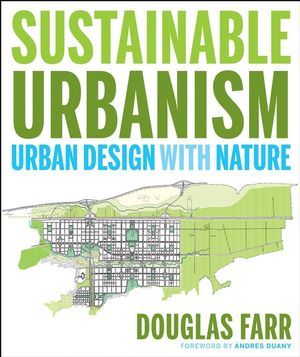February 01, 2008 Categories: Reviews
Sustainable Urbanism: Urban Design with Nature
Douglas Farr , Farr Associates, Chicago
2007. John Wiley & Sons. 304 pp. $75.

It’s not immediately obvious how Doug Farr’s new book differs from the many other books in this field, aside from having a laudatory preface by Andres Duany. The viewing-with-alarm part (“we are just coming to understand some terrible truths about the lifestyle choices made by the average American” {11}) has been done many times before, as have the case studies. His careful division of the case studies into built greenfield, unbuilt greenfield, built infill, and unbuilt infill, should be a clue. It’s also nice that he offers a fairly specific definition of the s-word in this context: “walkable and transit-served urbanism integrated with high-performance buildings and high-performance infrastructure,” with emphasis on density and access to nature. {42}
Farr’s book is distinguished by his systematic determination to reveal the trade secrets of sustainable design—those rules of thumb that bridge the gap between woolly generalities and highly specific case studies. With the help of a variety of experts, he’s gathered a bouquet of relevant numbers here, under the somewhat obscure heading, “Emerging Thresholds of Sustainable Urbanism.” For example, the reader learns that at eight houses per acre, stormwater runoff rates per house are 74 percent less than at one house per acre. {109} Car-sharing programs need at least 5 dwelling units per acre to work well. {167} Houses within a one-minute walk of a park sell for 24% more than comparable units elsewhere; those within 2 1/2 minutes of a park have a sales premium of only 15%. {170} Making these and other benchmarks more widely known helps break down barriers between different specialties and opens up possibilities for integrated design. {51-52}
Farr calls his book a first draft, which is appropriate, given the enormous gap between what we know about sustainable design and what we need to know. For instance, it seems odd that the only numbers we have for the minimum densities needed to support various levels of transit come from work done back in the 1970s by Pushkarev and Zupan in metropolitan New York City. {111}
But Farr isn’t just a technician, he’s a technician who wants to start a movement. He has hard words for Al Gore’s “An Inconvenient Truth”: “The 2006 documentary…avoided any mention of our country’s transportation and land use calamity. Besides suggesting the two actions a person could undertake with cars – pooling or sharing – the closest it came was this [toothless and context-free] recommendation: ‘Reduce the number of miles you drive by walking, biking, carpooling or taking mass transit wherever possible.’”
Farr continues: “The climate change dialogue to date has been all about technical fixes – better light bulbs, appliances, cars, buildings -…. We need to begin to demand both better widgets and sustainable urbanism now.” {57-58} This is a central point to which he returns frequently in interviews. For starters, he’d like to get his book into the hands of the thousands of well-meaning but largely untrained planning board members around the country. Perhaps inevitably, some will find his urgent movement-building rhetoric disquieting. The adoption of sustainable urbanism as a societal norm, Farr writes, “requires all of the many participants in the process of planning and developing the built environment to work as a single organism toward a shared purpose.” {12, emphasis added}
As a design product itself, the book is disappointing. In one important instance, Farr describes density as “the hot button of sustainable urbanism” (because it’s both a “sustainability silver bullet” and a magnet for public opposition), but the essential graphic on the following pages, depicting a range of densities using pictures, plans, and numbers, is almost unreadably small. {103-105}
The six case studies of built infill come from three continents: BedZED in South London (82 dwelling units on 4 acres); Glenwood Park in Atlanta (325 units on 28 acres); Holiday Neighborhood in Boulder (333 units on 27 acres); Christie Walk in Adelaide, Australia (27 units on 1/2 acre); Newington, Sydney, Australia (2000 units on 222 acres); and High Point in Seattle (1600 units on 100 acres). {214-237} Sustainable neighborhoods, Farr concludes, “are more than assemblages of energy-saving technologies,” they’re specifically adapted to their places. {210}
Farr draws a parallel between sustainable urbanism and the 1960s moon shot, in that both took years of work and inventiveness. The difference is that lunar exploration was a spectator sport for most Americans, and sustainable urbanism cannot be. In many ways it requires a cultural change. It “requires the improbable: that the base of the pyramid – millions of us – ‘get it’ and act in concert.” Without this, knowledge of design thresholds is for naught.
The odds are enormous but, he insists, they’re not insurmountable. “The entire built environment gets renewed or rebuilt every few generations, and we just need to do it differently.” {296}
—Harold Henderson
Henderson, the CBC’s communications consultant, has reviewed books for the American Planning Association’s magazine Planning for 20 years. From 1985 to 2007 he was a staff writer at the weekly Chicago Reader, covering many topics, including environmental and planning issues. The opinions expressed in these reviews are his and not necessarily those of the University of Notre Dame or its School of Architecture.
